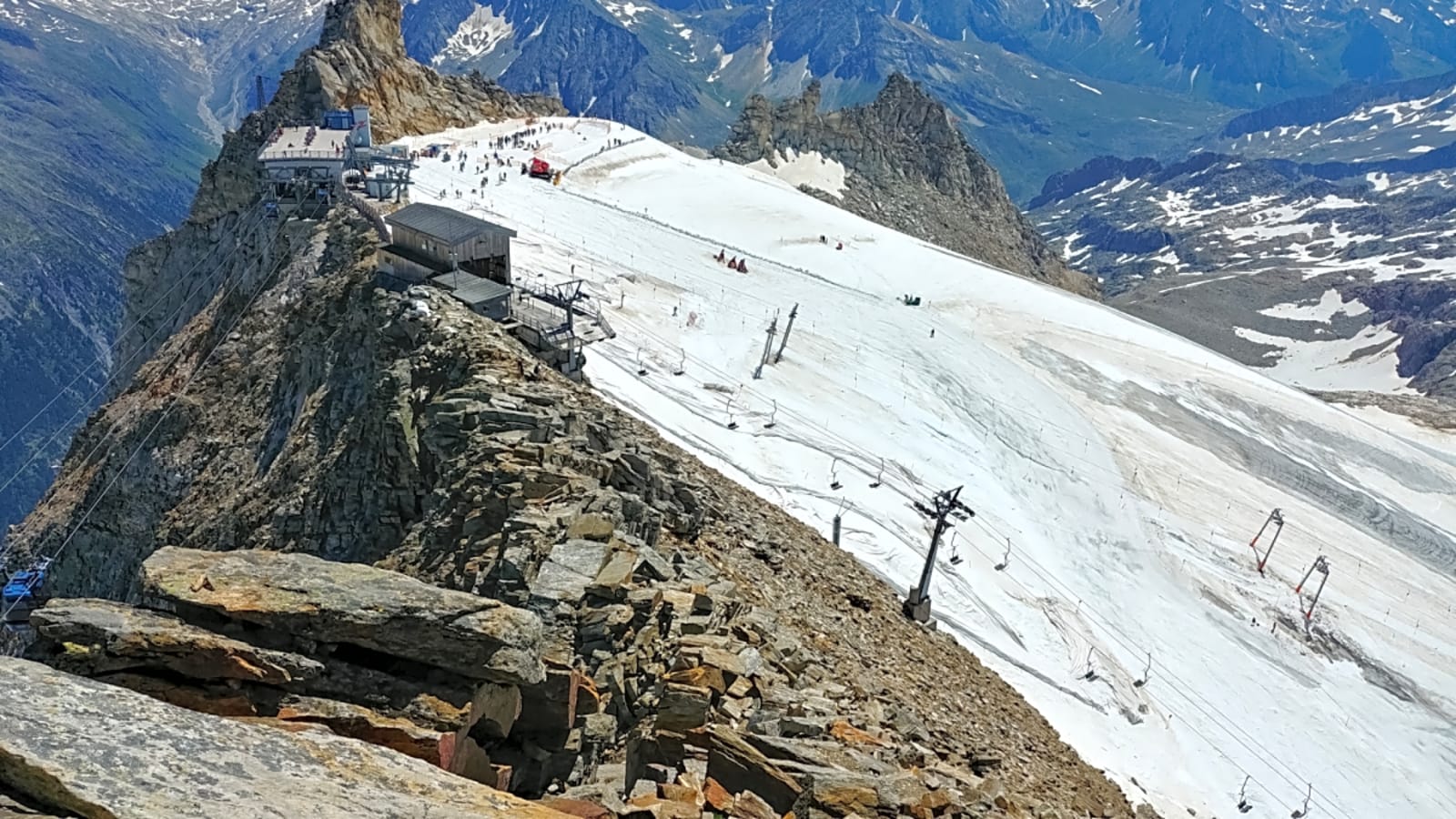
Glacier skiing? It sounds scary, we know, but in the context of ski resorts, sliding down glaciers isn’t just normal and safe; it’s a lot of fun. If you’ve ever wanted to ski year-round without leaving the northern hemisphere, these hulking, icy masses might be involved.
Here are the basics.
Want to keep up with the best stories and photos in skiing? Subscribe to the new Powder To The People newsletter for weekly updates.
What Is Glacier Skiing?
Glaciers are large, long-enduring blocks of snow, ice, water, and sediment that move under their own weight, slowly flowing like a river. They’re capable of withstanding the summer heat (although with less frequency due to climate change), making them perfect places to ski during the warmer months. While glaciers are popular among freestyle and alpine racing athletes hoping to train year-round, the general public can get in on the fun, too.
Many skiers will encounter glaciers at ski resorts that offer summer skiing without realizing it. In this context, they’re groomed and often slushy, making for an approachable ski surface. Hazards are marked, so ski resort visitors don’t need to worry about donning a harness or relying on other backcountry travel techniques unless otherwise specified.
In the backcountry, though, skiers have to be more aware of the risks associated with glaciers, like crevasses. Unexpectedly plunging into one of these glacial cracks, which sometimes aren’t visible from above, can result in serious injury or death. So, unless you’re trained in glacier travel or with a certified guide, always obey relevant signage and remain within the boundaries of the ski resort.

Where Can You Glacier Ski?
Numerous ski resorts around the world offer summer glacier skiing. While the bulk of these destinations are in Europe, one famous Oregonian ski resort is part of the glacial crowd, with a technical caveat.
Here are a few glacier ski resorts worth checking out:
- Zermatt, Switzerland: The Theodul Glacier is the centerpiece of Zermatt’s summer skiing offerings. Here, high above the town on warm summer days, skiers can take advantage of numerous ski runs and a terrain park that serves as a gathering point for top freestylers.
- Les 2 Alpes, France: The glacier Les 2 Alpes uses for its summer skiing piste spans nearly 300 acres with a multi-lane terrain and other slopes cater to those who want to get their carve on.
- Hintertux Glacier, Austria: At the Hintertux Glacier, skiers can hit the slopes year-round, making this spot a sure-bet. Just don't visit expecting powder turns in August, you'll need to head to the southern hemisphere for that.
- Tignes, France: At Tignes in the summer, skiers can ride the Grand Motte glacier, which reaches just above 11,000 feet and facilitates snowsports almost every month. The glacier is accessed with the Perce Neige, a funicular that begins in Val Claret.
- Timberline Lodge, Oregon: Timberline Lodge is a ski resort based on the flanks of Mt. Hood, Oregon, that remains open into the summer, thanks to a build-up of snow and ice first identified as the Palmer Glacier in 1924. Now known as the Palmer Snowfield, this formation has since stopped flowing and lost its glacier classification. Still, the snowfield remains skiable even when seasonal temperatures increase, allowing Timberline Lodge to consistently offer North America's longest lift-accessed ski season.

Glacier Skiing Tips
Most skiers know how to prepare for winter conditions, but in the postseason, a different set of rules apply. Down, Gore-Tex, and other cold-weather pieces of gear are usually unnecessary. Remember, you’re preparing for warm temperatures and soft snow—that might involve rocking a t-shirt.
- Start early (or late): At summer ski resorts, most days begin with firm snow. If you’re an aspiring World Cup racer, this is great—you want the bulletproof stuff. Fans of laying down a mean carve might be enthused, too. But more casual skiers, or those interested in venturing towards the terrain park, may want less icy snow. If you’re keen on slush, don’t rush to the mountain. Instead, wait until mid-morning to arrive. Just know that by the time the afternoon comes around, the snow will begin to become very slow and wet.
- Wear thinner layers: Thin, shell-style ski pants are always a safe bet in the summer. They provide protection from the snow in the case of fall and prevent your legs from getting wet. But you likely won’t need a jacket on top. Consider reaching for a sunproof long-sleeve shirt. A vest or sweatshirt can provide additional insulation, depending on the air temperature.
- Bring sunscreen and water: There's always the risk of sunburns in the mountains, but the sun can be downright brutal during the summer months on high alpine glaciers. So, bring plenty of sunscreen and apply it liberally. Nothing sours a summer ski vacation like burnt, peeling skin. Add a sizable jug of water to the packing list, too. The altitude and the heat can rapidly dehydrate you.
More must-reads:
- Buffalo Sabres' GM change isn't about rebuilding
- Season-ending injury to Micah Parsons puts microscope on Packers HC Matt LaFleur
- The 'Last 10-TD season by NFL team' quiz
Breaking News
Trending News
Customize Your Newsletter
 +
+
Get the latest news and rumors, customized to your favorite sports and teams. Emailed daily. Always free!








